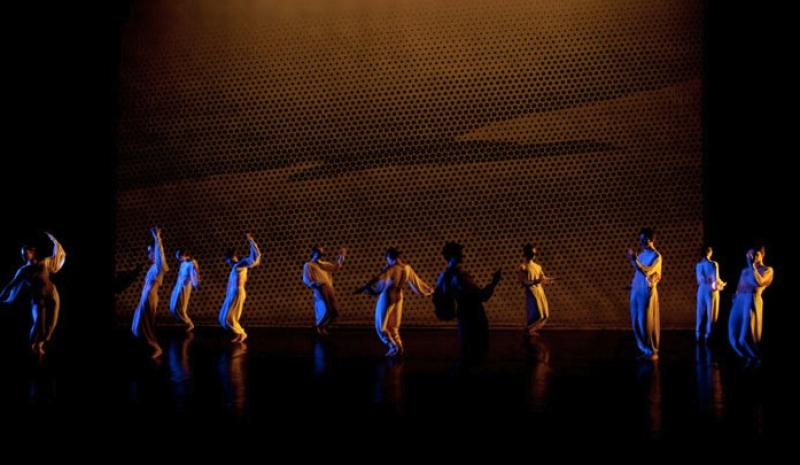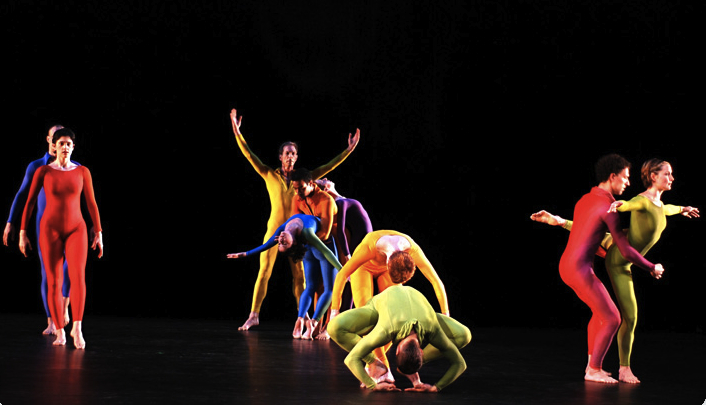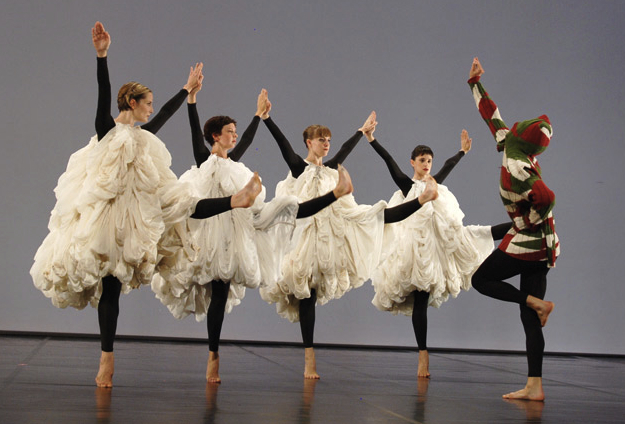Merce Cunningham Dance Company, Barbican Theatre | reviews, news & interviews
Merce Cunningham Dance Company, Barbican Theatre
Merce Cunningham Dance Company, Barbican Theatre
Laughter, playfulness, the lightness of being - the works of a genius choreographer are laid finally to rest

Any newcomers to Merce Cunningham who visit the last performances ever in Britain of his modern dance company - renowned, even notorious, for its abstruse abstractness - will surely go away with an impression of laughter, playfulness, the lightness of being.
Few choreographers plan their finale as exactly as Cunningham did before he died, aged 90, in 2009. A two-year “legacy” tour around the globe, dancing choice pieces to the audiences who’d loved and sought out this inimitable dance-maker, London high on the list, having offered the Americans almost a second home in the past 20 years.
 Last night we had the revivifying Roaratorio, which is like a dance class in the city that keeps breaking out into an Irish get-together, dancers in mix-and-match colours, holding hands and jigging, while sounds fly in as if through an open window - traffic, children in the park, snatches of Irish fiddle-playing, chunks of James Joyce poetry, a crooning vagrant wandering by. The score is one of the many made for Merce, his partner, by John Cage, the mischievous, ever-stimulating composer and apostle of chance.
Last night we had the revivifying Roaratorio, which is like a dance class in the city that keeps breaking out into an Irish get-together, dancers in mix-and-match colours, holding hands and jigging, while sounds fly in as if through an open window - traffic, children in the park, snatches of Irish fiddle-playing, chunks of James Joyce poetry, a crooning vagrant wandering by. The score is one of the many made for Merce, his partner, by John Cage, the mischievous, ever-stimulating composer and apostle of chance.
The dancers skip and leap, or relax on bar stools at the side, watching each other. There is no beginning, middle or end, though the light faintly dims as if the day is passing; there is only your attention span, which - as far as I was concerned - becomes limitlessly tolerant of this balmy experience. Roaratorio is danced again tonight, and if you have any tensions in your life, I recommend its therapy.
Sadly there’s no repeat for the first night, a trio of dances embracing the witty, impish Fifties Merce, the mysterious, compelling Seventies Merce and the astonishing, computer-tooled Merce of the Nineties. Decors by Roy Lichtenstein, Jasper Johns and Robert Rauschenberg reminded you that Cunningham was a leading catalyst for America's Abstract Expressionism movement, music by Cage and by Brian Eno told you of Cunningham’s allure for contemporary experimental composers. Tomorrow’s programme, the final farewell, has Andy Warhol and the digital inventors Shelley Eshkar and Paul Kaiser on the collaborators’ list.
Such names only, really, for Cunningham - his method of commissioning music and decor independently of his choreography (he would give a time period only to them, no name, no theme, it was up to them) produced again and again works that somehow gelled to arouse a feeling, an association, an emotion. He never asked for emotion, but you very likely felt it, virus-like, infecting the hard drive.
Pond Way, seen on Wednesday, may have been chosen for this tour because, for once, name, sound and visual impression are unusually united - this is virtually a Monet in dance. One can easily read in the soft pixellated black-and-white abstract of Lichtenstein’s a smudge of a water lily here, the hollow of a ripple there. Eno’s composition for “three CD players”, New Ikebukuro, is quiet, meditative, dappled music, and the dancers, in white draped costumes, skip and hop as lightly as mayflies on the water’s surface. Yet the moves they do were built on computer, demands evidently exceeding the capability of even his own dancers the other night, flipping unlikely assortments of leg, arm and torso instructions together.
 That pre-computer Cunningham was doing boldly inventive things to the way the body moves was powerfully evident in Second Hand, from 1970, which we’d never seen in Britain before. In an empty black stage, costumed in Smartie-coloured unitards by Jasper Johns (pictured left), this launched with a breathtaking solo for a man, once Cunningham himself, and now his veteran disciple, Robert Swinston. A pianist in the pit picks out with a single finger something a little like a Bach fugal theme, which becomes an unending string of single notes, sometimes doubled in octave with the other hand, but never adding any harmony, seeming to have no destination.
That pre-computer Cunningham was doing boldly inventive things to the way the body moves was powerfully evident in Second Hand, from 1970, which we’d never seen in Britain before. In an empty black stage, costumed in Smartie-coloured unitards by Jasper Johns (pictured left), this launched with a breathtaking solo for a man, once Cunningham himself, and now his veteran disciple, Robert Swinston. A pianist in the pit picks out with a single finger something a little like a Bach fugal theme, which becomes an unending string of single notes, sometimes doubled in octave with the other hand, but never adding any harmony, seeming to have no destination.
Because Swinston is into his sixties now, his halting quality of movement now layers a strong association of questions, hesitation, onto these eccentric moves - it became a metaphor for an older man searching for answers, and I thought very moving. A younger woman joins him in what becomes a sort of pas de deux. They look intently into each other’s faces as they join hands, her leaps are small, light, effortless, with a balletic grace, they are the two faces of time, looking back and looking forward. The group that then joins them appears to swallow her up, leave the man isolated in a spotlight, his hand signalling for rescue, looking for her. I have once again fallen into the trap of reading a narrative into a Cunningham piece, but it’s an impulse I can’t resist, so richly and uninhibitedly did those dancers embed humanity into that wonderful piece.
 Antic Meet, the earliest piece from 1958, made a killer of a finale, a madly funny and crisply timed vaudeville, a kind of Have I Got Dance for You satire on modern life and culture. A man with a chair tied to his waist (Theatre of the Absurd), an eagerly yielding woman in a frilly country pinny (Martha Graham), sudden appearances of bunches of flowers or an umbrella with Christmas lights on, chic black-sunglasses-wearing babes in black, a chap lost in an outrageous sweater with far too many sleeves and no opening for the head. His encounter with can-can girls dressed in parachutes (pictured right) is the giddiest comedy of teenage inadequacy you'll ever see.
Antic Meet, the earliest piece from 1958, made a killer of a finale, a madly funny and crisply timed vaudeville, a kind of Have I Got Dance for You satire on modern life and culture. A man with a chair tied to his waist (Theatre of the Absurd), an eagerly yielding woman in a frilly country pinny (Martha Graham), sudden appearances of bunches of flowers or an umbrella with Christmas lights on, chic black-sunglasses-wearing babes in black, a chap lost in an outrageous sweater with far too many sleeves and no opening for the head. His encounter with can-can girls dressed in parachutes (pictured right) is the giddiest comedy of teenage inadequacy you'll ever see.
The pity is that the original props can’t be seen, but Carolyn Brown, in her memoir of a long career with Cunningham, Chance and Circumstance, describes how the infamous sweater was sewn from triangles knitted by many hands in the company. The current sweater looks, sadly, expertly made. Roll on tomorrow night, and the fabulously promising finale - the film of Ocean, Rain Forest (with the silver Warhol pillows) and that masterpiece of the digital video age, BIPED. It’s heartbreaking that these will no longer exist to be danced, seen and pored over in wonder and mystification.
- Merce Cunningham Dance Company performs Roaratorio tonight, and Rain Forest/ BIPED tomorrow evening at the Barbican Theatre. The film of Ocean is screened in the Barbican Cinema at 4pm
- The "Legacy" tour continues to Paramount Theater, Seattle, 27-29 October; Stanford Lively Arts, Stanford, 1 November; Walker Art Center, Minneapolis, 4-6 November; University of Notre Dame, Notre Dame, 10-12 November; University of Illinois, Urbana, 15 November; Dance Center at Columbia College and the Harris Theater, Chicago, 18-19 November; John F. Kennedy Center, Washington, DC 2-3 December; Brooklyn Academy of Music, New York, 7-10 December; Théâtre de la Ville, Paris, 15-23 December; and finally Park Avenue Armory, New York, 29-31 December
- Other Barbican events reviewed on theartsdesk
Below, Cunningham and Carolyn Brown in 1965 perform an excerpt from Variations V
Buy
Explore topics
Share this article
The future of Arts Journalism
You can stop theartsdesk.com closing!
We urgently need financing to survive. Our fundraising drive has thus far raised £49,000 but we need to reach £100,000 or we will be forced to close. Please contribute here: https://gofund.me/c3f6033d
And if you can forward this information to anyone who might assist, we’d be grateful.

Subscribe to theartsdesk.com
Thank you for continuing to read our work on theartsdesk.com. For unlimited access to every article in its entirety, including our archive of more than 15,000 pieces, we're asking for £5 per month or £40 per year. We feel it's a very good deal, and hope you do too.
To take a subscription now simply click here.
And if you're looking for that extra gift for a friend or family member, why not treat them to a theartsdesk.com gift subscription?
more Dance
 'We are bowled over!' Thank you for your messages of love and support
Much-appreciated words of commendation from readers and the cultural community
'We are bowled over!' Thank you for your messages of love and support
Much-appreciated words of commendation from readers and the cultural community
 R:Evolution, English National Ballet, Sadler's Wells review - a vibrant survey of ballet in four acts
ENB set the bar high with this mixed bill, but they meet its challenges thrillingly
R:Evolution, English National Ballet, Sadler's Wells review - a vibrant survey of ballet in four acts
ENB set the bar high with this mixed bill, but they meet its challenges thrillingly
 Like Water for Chocolate, Royal Ballet review - splendid dancing and sets, but there's too much plot
Christopher Wheeldon's version looks great but is too muddling to connect with fully
Like Water for Chocolate, Royal Ballet review - splendid dancing and sets, but there's too much plot
Christopher Wheeldon's version looks great but is too muddling to connect with fully
 iD-Reloaded, Cirque Éloize, Marlowe Theatre, Canterbury review - attitude, energy and invention
A riotous blend of urban dance music, hip hop and contemporary circus
iD-Reloaded, Cirque Éloize, Marlowe Theatre, Canterbury review - attitude, energy and invention
A riotous blend of urban dance music, hip hop and contemporary circus
 How to be a Dancer in 72,000 Easy Lessons, Teaċ Daṁsa review - a riveting account of a life in dance
Michael Keegan-Dolan's unique hybrid of physical theatre and comic monologue
How to be a Dancer in 72,000 Easy Lessons, Teaċ Daṁsa review - a riveting account of a life in dance
Michael Keegan-Dolan's unique hybrid of physical theatre and comic monologue
 A Single Man, Linbury Theatre review - an anatomy of melancholy, with breaks in the clouds
Ed Watson and Jonathan Goddard are extraordinary in Jonathan Watkins' dance theatre adaptation of Isherwood's novel
A Single Man, Linbury Theatre review - an anatomy of melancholy, with breaks in the clouds
Ed Watson and Jonathan Goddard are extraordinary in Jonathan Watkins' dance theatre adaptation of Isherwood's novel
 Peaky Blinders: The Redemption of Thomas Shelby, Rambert, Sadler's Wells review - exciting dancing, if you can see it
Six TV series reduced to 100 minutes' dance time doesn't quite compute
Peaky Blinders: The Redemption of Thomas Shelby, Rambert, Sadler's Wells review - exciting dancing, if you can see it
Six TV series reduced to 100 minutes' dance time doesn't quite compute
 Giselle, National Ballet of Japan review - return of a classic, refreshed and impeccably danced
First visit by Miyako Yoshida's company leaves you wanting more
Giselle, National Ballet of Japan review - return of a classic, refreshed and impeccably danced
First visit by Miyako Yoshida's company leaves you wanting more
 Quadrophenia, Sadler's Wells review - missed opportunity to give new stage life to a Who classic
The brilliant cast need a tighter score and a stronger narrative
Quadrophenia, Sadler's Wells review - missed opportunity to give new stage life to a Who classic
The brilliant cast need a tighter score and a stronger narrative
 The Midnight Bell, Sadler's Wells review - a first reprise for one of Matthew Bourne's most compelling shows to date
The after-hours lives of the sad and lonely are drawn with compassion, originality and skill
The Midnight Bell, Sadler's Wells review - a first reprise for one of Matthew Bourne's most compelling shows to date
The after-hours lives of the sad and lonely are drawn with compassion, originality and skill
 Ballet to Broadway: Wheeldon Works, Royal Ballet review - the impressive range and reach of Christopher Wheeldon's craft
The title says it: as dancemaker, as creative magnet, the man clearly works his socks off
Ballet to Broadway: Wheeldon Works, Royal Ballet review - the impressive range and reach of Christopher Wheeldon's craft
The title says it: as dancemaker, as creative magnet, the man clearly works his socks off
 The Forsythe Programme, English National Ballet review - brains, beauty and bravura
Once again the veteran choreographer and maverick William Forsythe raises ENB's game
The Forsythe Programme, English National Ballet review - brains, beauty and bravura
Once again the veteran choreographer and maverick William Forsythe raises ENB's game

Add comment